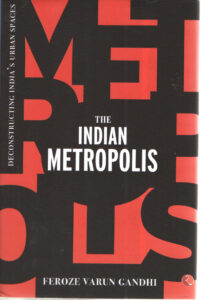The Indian Metropolis: Deconstructing India’s Urban Spaces
By Feroze Varun Gandhi
Let the People Plan Their Cities
By A.G. Krishna Menon
Traditionally, Indians have had a love-hate relationship with the city. Even they who seek it’s benefits valorise the rural idyll. This ambivalence is reflected in contemporary urban policies and practices of the government, and, not surprisingly, the state of Indian cities is defined by their apparently intractable problems, which seem to defy the imagination of professionals or the resources of the government.
Feroze Varun Gandhi, a young politician with the rare passion to seriously engage with the complex problems of both urban and rural habitats has, however, bravely endeavoured to confront the problems of cities and present alternative approaches to mainstream ideas of urban development in this massive tome, The Indian Metropolis: Deconstructing India’s Urban Spaces. It deserves serious consideration.
In nine chapters, he covers a wide range of urban issues, from examining the characteristics of urbanisation to water availability, urban crime, healthcare, transport, affordable housing, urban unemployment and business, and urban finance. Finally, he focuses on the practice of urban planning, where he suggest that the management of cities could be reformed by engaging with the stakeholders in a holistic dialogue.
Each chapter is a mini book on the subject it discusses, spanning 70 to 80 pages on an average, which concludes by suggesting the way forward to resolve the problems that have been highlighted. The text is annotated with copious footnotes and an extensive bibliography.
It is obviously difficult to convey the gist of this voluminous study, but to convey its spirit, and in brief, Varun makes five recommendations to transform our cities. He cites the need to ”embrace the informal sector and make it easier for them to expand…such initiatives need to be written into the urban character of our cities and supported by operational statutes governing the city”. Second, radically shift our realty markets towards providing affordable housing. Third, fix transport by focusing on moving people instead of vehicles. Additionally, he emphasises the need to focus on education and healthcare, citing the initiatives taken in Delhi as a template to follow.
What needs to be highlighted in this eclectic survey of Indian urbanism is the humane and pragmatic nature of the author’s vision to transform cities. It is not predicated on the aggrandising rhetoric of creating a ‘New India’ that underpins current urban transformation strategies. Instead, Varun recommends that citizens should be empowered and, as informed interlocutors, they should contribute to the resolution of urban problems. This calls for a paradigm shift in urban governance from a ‘top-don’ to a ‘bottoms-up’ process to manage cities. This is what the 73rd and 74th constitutional amendments had suggested; revisiting them is timely, because e are at the cusp of massive urban growth and there is urgent need to develop innovative strategies to forestall its deleterious consequences.
However, the book has two shortcomings. Its encyclopaedic structure makes it difficult to engage with it effectively. As Varun acknowledges, he has “drawn on the resources and goodwill of a variety of people, including my research team”, which has resulted in a potpourri of good ideas, but this wishlist lacks narrative coherence or editorial discipline. The chapter on urban planning, for instance, which should have anchored the book, is a chaotic description of the history of urban planning that highlights global perceptions on the efficacy of master planning, and reads like a rhetorical commentary.
Secondly, the book covers almost every aspect of managing cities, but not the elephant in the room, which is authoritarian political interference. The original objectives of the Delhi Master Plan, for instance, have been decimated to implement an urban renewal project in pursuit of ‘politics by other means’ to create the ‘New India’. In the process, it has vitiated the culture of democratic urban planning, which this book tries valiantly to uphold.
A.G. Krishna Menon is an architect and urban planner.


0 thoughts on “The Indian Metropolis: Deconstructing India’s Urban Spaces”